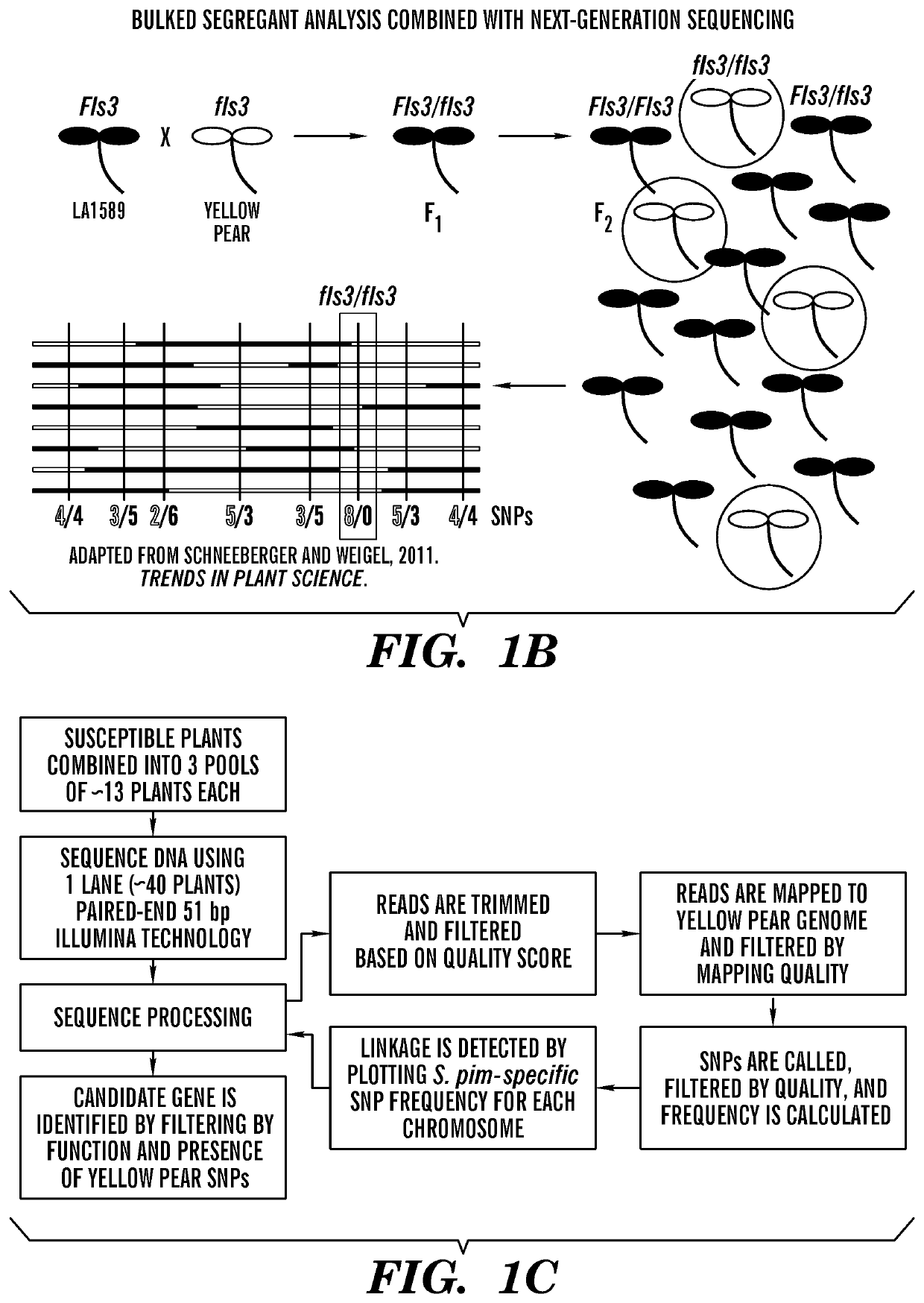Flagellin-sensing 3 (‘FLS3’) protein and methods of use
a technology of fls3 and fls2, which is applied in the field of disease resistance in plants, can solve the problems of little progress in the identification and analysis of key regulators of pathogen resistance, and cannot offer the possibility of interspecies transfer, so as to enhance disease resistance, enhance the efficiency of plant transformation, and reduce or eliminate the expression of fls3
- Summary
- Abstract
- Description
- Claims
- Application Information
AI Technical Summary
Benefits of technology
Problems solved by technology
Method used
Image
Examples
example 3
Protocol
[0099]Materials:
[0100]Luminol (17 mg / mL in DMSO); horseradish peroxidase type VI (10 mg / mL in H2O; cork borer #1 or 2; 96-well microplates
[0101]Procedure:
[0102]Leaf disks were obtained using the cork borer, and disks were floated on water in 96-well microplates, adaxial (upper) side facing up. After overnight incubation, the water was removed and replaced with 100 μL per well ROS assay solution (34 μg / mL luminol, 20 μg / mL horseradish peroxidase, with an appropriate concentration of the MAMP of interest). The resulting luminescence was measured using a plate reader (i.e., Biotek Synergy 2 with Gen5 1.10 software). The luminescence was measured over 45 minutes with a 27 millisecond interval for a total of 101 reads.
example 4
for Demonstrating Binding of flgII-28 to FLS3
[0103]Procedure: Approximately 25 grams of Nicotiana benthamiana tissue overexpressing FLS3 with a c-terminal GFP tag fusion was ground in a mortar with a pestle in liquid nitrogen. 200 mL of extraction buffer (50 mM MOPS-KOH, pH7.5, 0.5 M sorbitol, 5 mM DTT, 5 mM EDTA, pH8.0, 1% PVPP, 1 mM PMSF) was then added to the ground tissue and the extract was filtered through Miracloth. The extract was centrifuged in 40 mL round-bottom tubes at 10,500 rpm for 25 minutes at 4° C. 40 mL of supernatant was transferred to each of 6 open-top tubes and centrifuged for 75 minutes at 23,600 rpm (100,000×g) at 4° C. Microsomal membranes were suspended in 10 mL of suspension buffer (25 mM Tris-HCl, pH7.5, 0.25 M sucrose, 10 mM potassium phosphate, pH7.5, 28.8 mM NaCl). Samples were then sonicated for 2×30 seconds at half power with samples kept in an ice bath. 9 mL of suspended microsomal membranes was then added in 27 g phase mixture (6% w / w dextran T-500...
example 5
ation of FLS3
[0104]Using an F2 population, mapping-by-sequencing was performed followed by fine mapping to identify a gene encoding a RLK that is linked to flgII-28 responsiveness in tomato. In order to identify the responsible gene by bulked segregant analysis, segregating populations were generated by crossing flgII-28 sensitive (LA1589) and insensitive (Yellow Pear) accessions (FIGS. 1A-1B). Testing for the sensitivity of F2 plants to 100 nM flgII-28 treatment using the ROS assay revealed a segregation ratio of LA1589×Yellow Pear of 468:108. To identify the genomic region linked to flgII-28 insensitivity, DNA libraries for next-generation Illumina® sequencing were generated using flgII-28 non-responsive F2 plants, sent for sequencing, and mapped onto a Yellow Pear genome (FIGS. 1C-1D). Only chromosome 4 had a notable deviation from the expected 1:1 LA1589:Yellow Pear SNP ratio, with one region in particular having very few LA1589-specific SNPs (FIGS. 1D-1E). This region, spanning...
PUM
| Property | Measurement | Unit |
|---|---|---|
| diameter | aaaaa | aaaaa |
| temperature | aaaaa | aaaaa |
| concentration | aaaaa | aaaaa |
Abstract
Description
Claims
Application Information
 Login to View More
Login to View More - R&D
- Intellectual Property
- Life Sciences
- Materials
- Tech Scout
- Unparalleled Data Quality
- Higher Quality Content
- 60% Fewer Hallucinations
Browse by: Latest US Patents, China's latest patents, Technical Efficacy Thesaurus, Application Domain, Technology Topic, Popular Technical Reports.
© 2025 PatSnap. All rights reserved.Legal|Privacy policy|Modern Slavery Act Transparency Statement|Sitemap|About US| Contact US: help@patsnap.com



